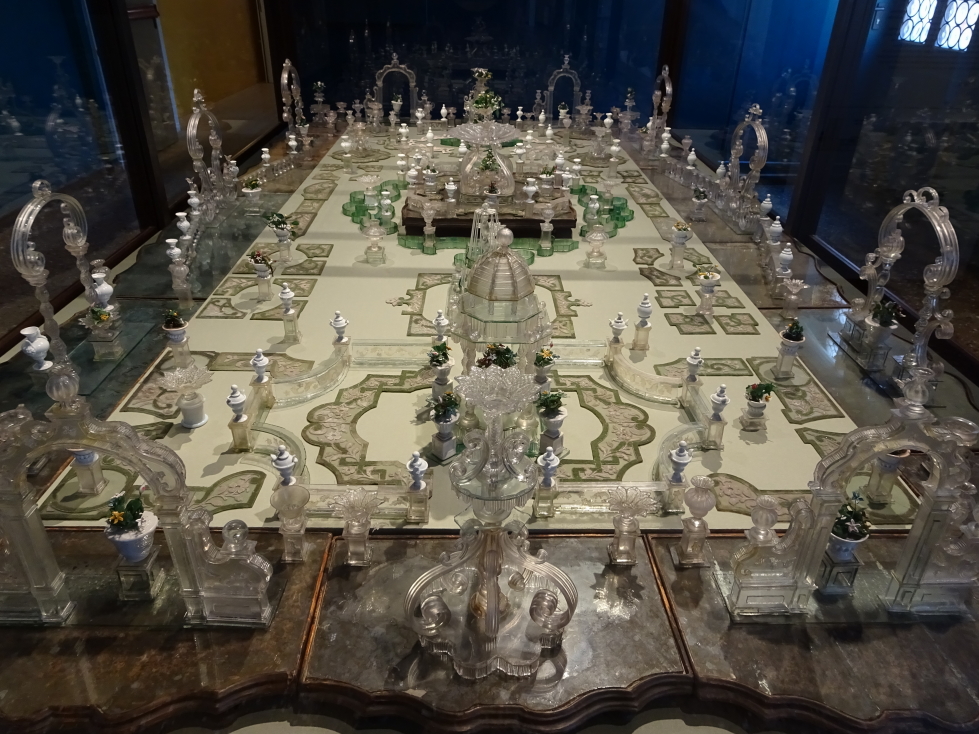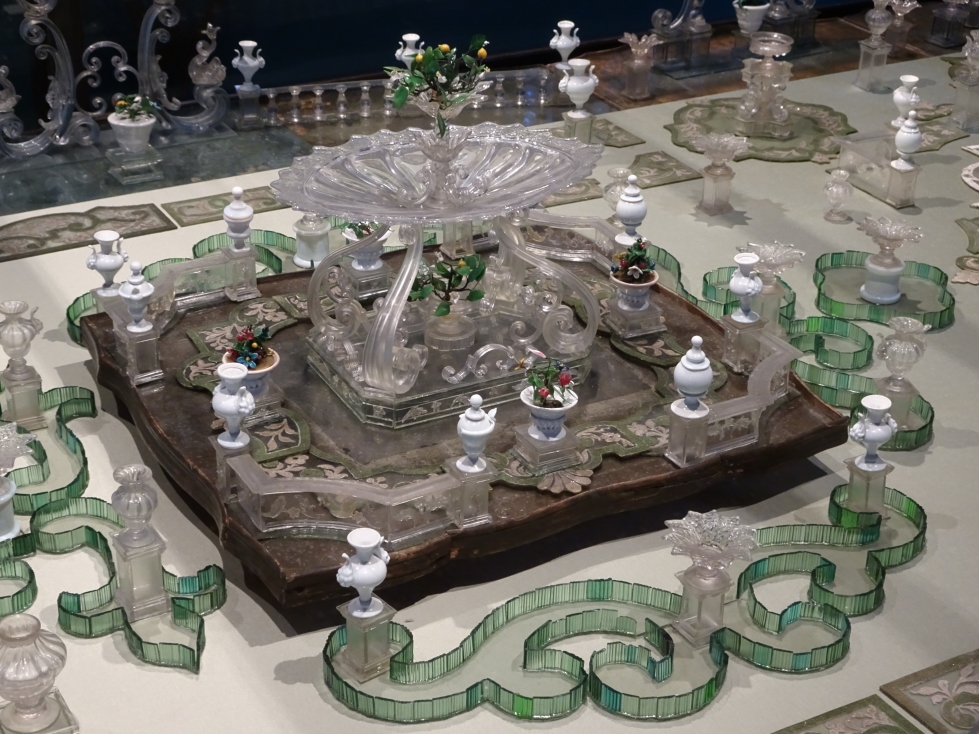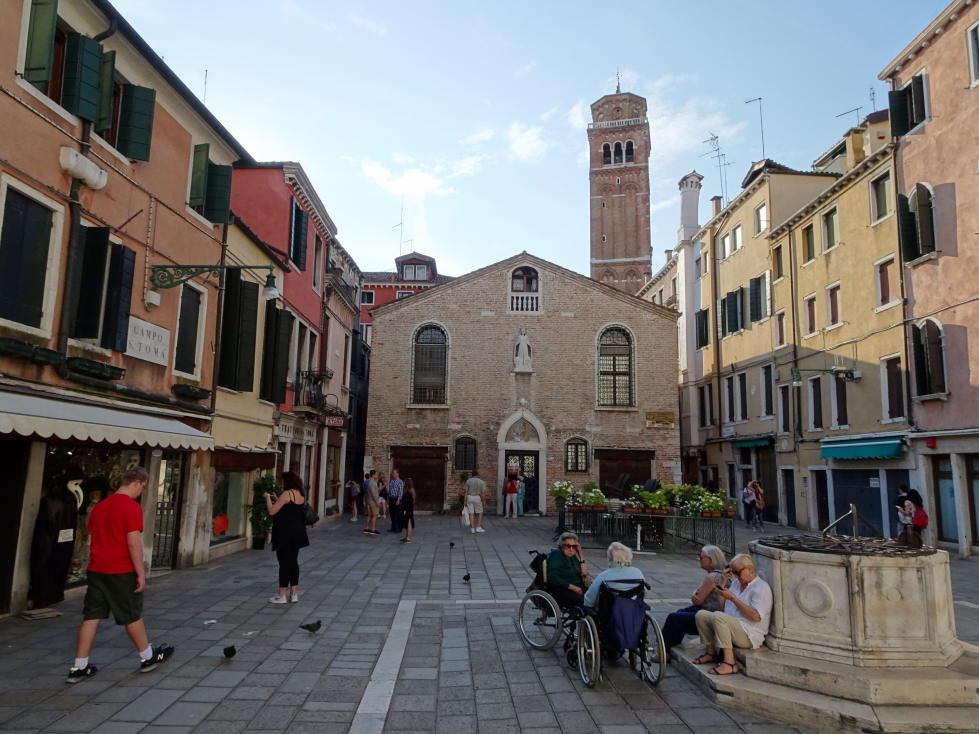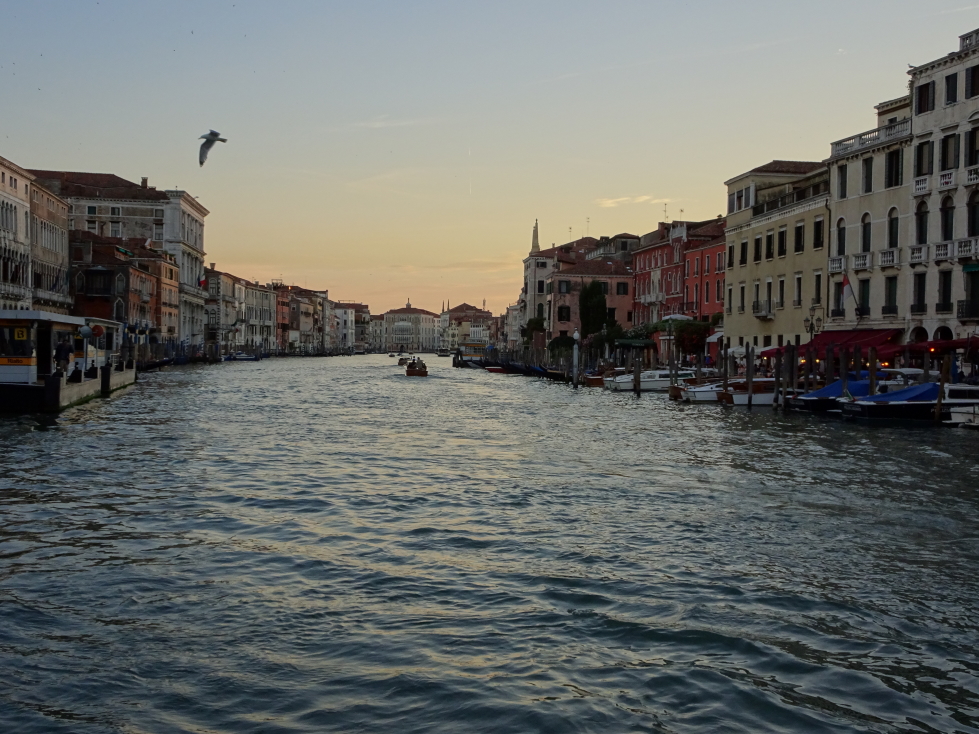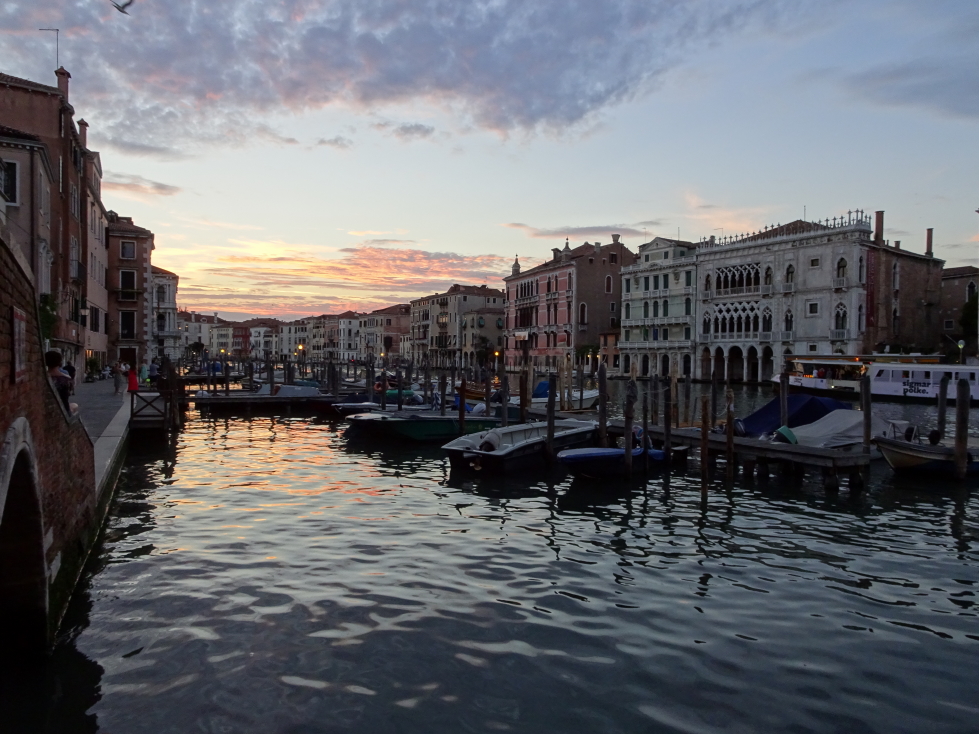Awoke at 6a and blogged a bit before breakfast at 8:30a, eventually setting out around 10a. Our first errand of the day was looking for some boxers for Addison. We were pointed in the direction of a department store called “COIN” which took up an entire block and was four stories of stuff. Amusingly there was a section called “Intimo Donna — lingerie and seduction”; they don’t mince words in Italy! Found some boxers but they were 30+ euros each. Yeah, no.
We walked past the Duomo and Baptistry (with its impressive — if facsimile, as the originals are safely stored away from the elements — doors) and on to the Accademia Gallery. We were admitted in pretty short order. First we saw the ubiquitous religious pre-Renaissance art then an exhibition of instruments that the Medici owned including a violin cello and harpsichords. They also had a serpent, a long, snake-like ancestor of the tuba.

Little flourishes abound in Florence, like this symbol of the town

Entrance to Cattedrale di Santa Maria del Fiore, or the Duomo

A serpent, an instrument that is an ancestor to the tuba
Back in the museum proper we saw a sculpture (well, actually the sculptor’s model or gesso) meant to be viewed at any angle consisting of three twisting figures called “Rape of the Sabines”. Saw more creepy skulls at the bases of the cross and the creepiness was upped even more by baby heads with red wings flitting about.

Sculptor’s model of “Rape of the Sabines” by Giambologna, ca. 1580

Creepy smiling skull with even creepier flying baby heads!
Next up was “David”. It was on display in a brightly lit room and commanded the space. It was far taller than I thought it’d be as well. Despite seeing it all of my life (and certainly all over Florence not only as a copy in front of the Palazzo Vecchio but also as a tiny statue, on t-shirts, etc. at every single tourist trap) it was still amazing to see it in person. I was particularly struck by the lifelike pose and the vein marbled hands holding the stone (which Michelangelo sculpted proportionally larger than is natural to make it more impressive).

“David” by Michelangelo, 1501-1504
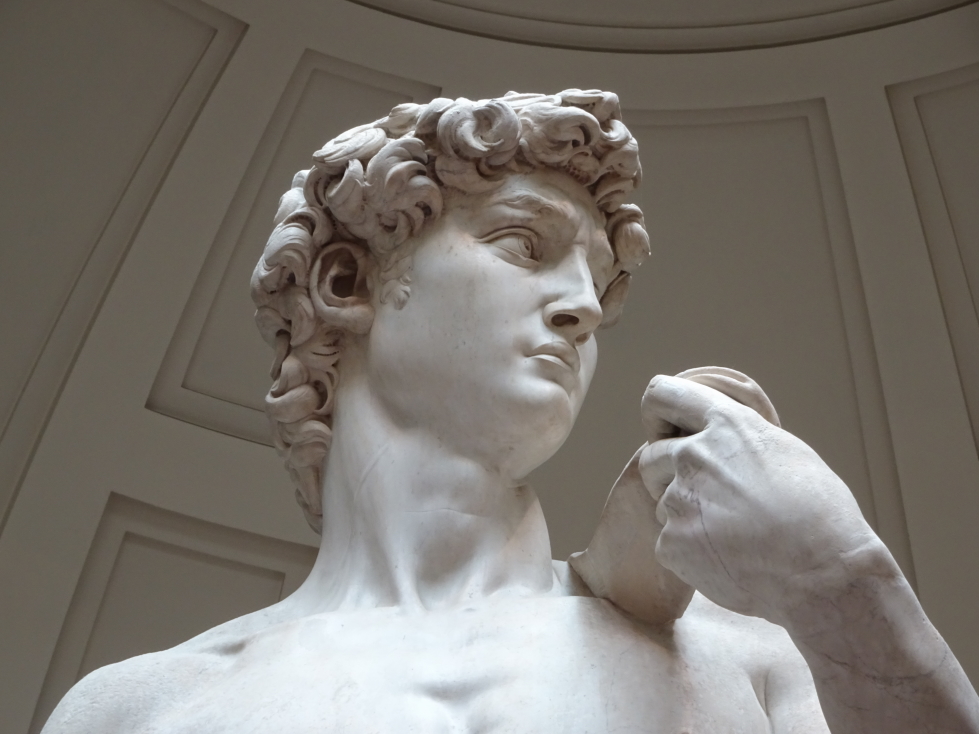
Closeup of the head of “David”

My what big hands you have!
Leading up to “David” was a series of unfinished sculptures called (appropriately enough) the “Prisoners” as they are trapped in stone. They were originally intended for the tomb of Pope Julius II but the plans were scrapped due to funds running short and remained in his workshop unfinished. There was also “Pieta di Palestrina” in the hall.

The Hall of the Prisoners with “David” beyond
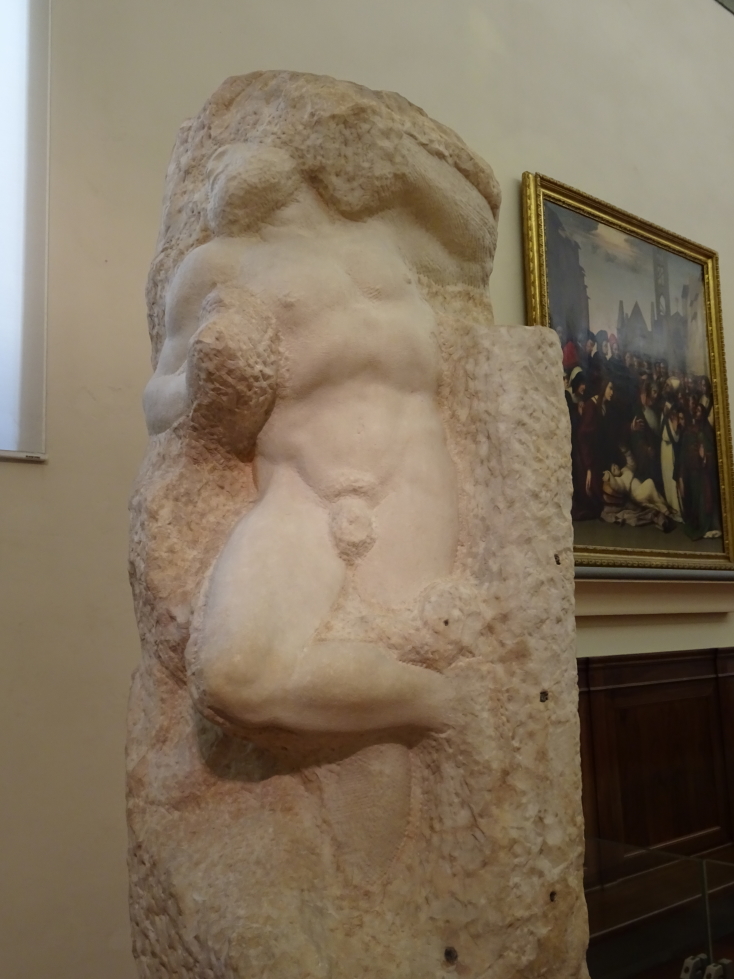
One of the Prisoners, an unfinished sculpture by Michelangelo

Michelangelo’s “Pieta di Palestrina”
The next room contained many objects (statues, casts, etc.) found in sculptors’ workshops. Heading upstairs there were some amazing tapestries and 1300s embroidery and other Christian art.

Sculpture in the “workshop”

“Workshop” hall in Florence’s Accademia Gallery

Amazing embroidery from the 1300s, made in Florence

Beautiful religious art from the Middle Ages
Headed back outside and got some take-out Subway for Addison and booked a tour of parts of Tuscany we couldn’t reach via train at an office nearby. We then headed to Brio Pizzeria where Addison had some roasted potatoes, Michelle a mushroom and sausage pizza, and myself a ham, sausage, and salami pizza. At an adjacent table people in a cooking class were eating what they cooked and seemed to be having a great time. Next trip, perhaps!

Entrance to the Duomo

Campanile di Giotto with the entrance to the cathedral to the left and dome to the right

Closeup of Duomo’s dome
Arrived at the hotel room for siesta (a custom I love very much!) from 2:30p until 4p. At 4p we got some (very pricey, even for Florence) gelato then went on to Basilica di Santa Croce di Firenze. In front of the church a construction crew was tearing down bleachers and what looked to be a jousting ground — sadly we may have missed a really cool event from the prior day’s holiday. Oh well.

Front of Basilica di Santa Croce di Firenze

Jousting grounds being torn down in front of Santa Croce
It is a testament to the embarrassment of riches that Florence has sight-wise that Santa Croce isn’t on must-see lists. Not only does it have amazing chapels, reliquaries, and stained glass but it is also home to the tombs of three giants: Machiavelli, Galileo, and Michelangelo. One would be hard pressed to think of many heavier hitters in their particular fields. The tomb of Michelangelo in particular was incredibly beautiful. Three ladies — representing sculpture, painting, and architecture — sit about his sarcophagus looking lost and sad.

Michelangelo’s tomb at Santa Croce

The three ladies, representing sculpture, painting, and architecture, surrounding Michelangelo’s sarcophagus
Well-worn graves from dating all the way back to the Middle Ages were scattered around the floor of the church. After admiring a statue that was similar to our Lady Liberty as well as the numerous chapels, all lavishly painted, and a reliquary of a golden head containing a skull dedicated to the cult of a nun we headed out to the cloisters. We checked out a room used as a meeting hall as well as a stick showing the height of historic floodwaters, topped by 1966’s catastrophic flood. A small museum contained more artifacts. As the church was closing we headed back outside and were treated to the basilica’s bells ringing above. Sorry about the following deluge of pictures, but Santa Croce was really breathtaking!

“Liberty of Poetry”, inspiration for the Statue of Liberty

Detail of the ceiling of Santa Croce

Beautiful fresco in a side chapel

Altar at Santa Croce

Stained glass at Santa Croce

Even the underside of arches are lavishly painted

One of Santa Croce’s chapels

Main altar and cross of Santa Croce

Closeup of the cross at Santa Croce

Stained glass window

Elevated walkway with cool black and white marble decoration

Flood marker showing historic flood levels, topped by the epic 1966 flood

Cloisters at Santa Croce

Bell tower of Santa Croce
Headed back towards the room, stopping to see some of the sculptures in Loggia dei Lanzi. The Loggia is an open air covered sculpture garden adjacent to the Piazza della Signoria, the piazza where Palazzo Vecchio is situated.
Arrived back at the room at 6p and rested until 8p (second siesta? nice!). Afterwards headed out for dinner, crossing the Ponte Vecchio to the south bank of the Arno. The bridge was originally the home to many butchers, the offal and other remains being dropped directly below and carried downstream to the sea. When the Medici came to power they cleaned up the area and installed a walkway from their offices on the south bank to the center of government at the Palazzo Vecchio. As butcher shops would certainly not do they were replaced with gold and silver shops — and those establishments remain to this day. There were many flags along the route and as many shops were closed they were locked behind very sturdy steel enclosures. The bridge, even at the late hour, was crowded.

Florence street scene

I used to call milk “mookie” as a kid, and turns out I wasn’t wrong!
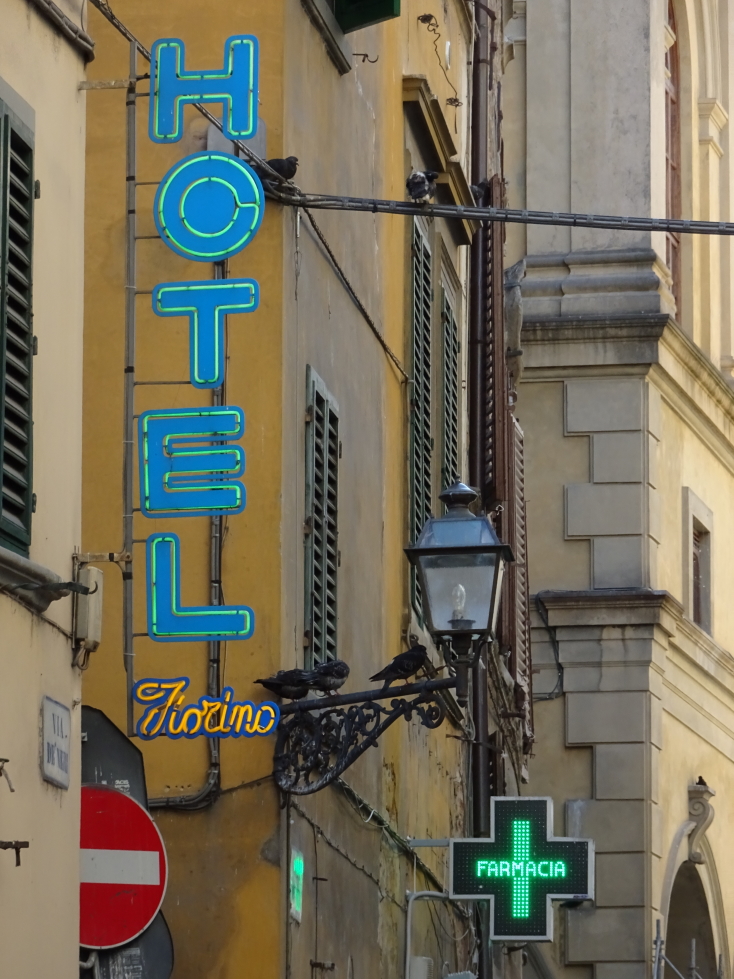
Love all the colorful signs!

Italian pharmacy, all the ones we saw had similar decor

Cellini’s “Perseus with the Head of Medusa”, 1545

Giambologna’s “Rape of the Sabines”

View of the Arno from Ponte Vecchio

Flags lining the gold and jewelry stores of Ponte Vecchio
We dined to Lungarno23, a burger joint. There was a lot of construction along the way, Genetta would later tell us it was to repair a sinkhole that occurred as part of the significant rain she encountered earlier in June. Michelle had a bacon and cheese burger with green apple salad and some chocolate cake. Addison had a bacon and cheese burger and fries, as did I. Heading back across the bridge we passed a group playing Pink Floyd’s “Wish You Were Here” and head to our room and bed.

Ponte Vecchio at night from the Arno’s south bank

Ponte Vecchio at night, note the closed store coverings





































































































